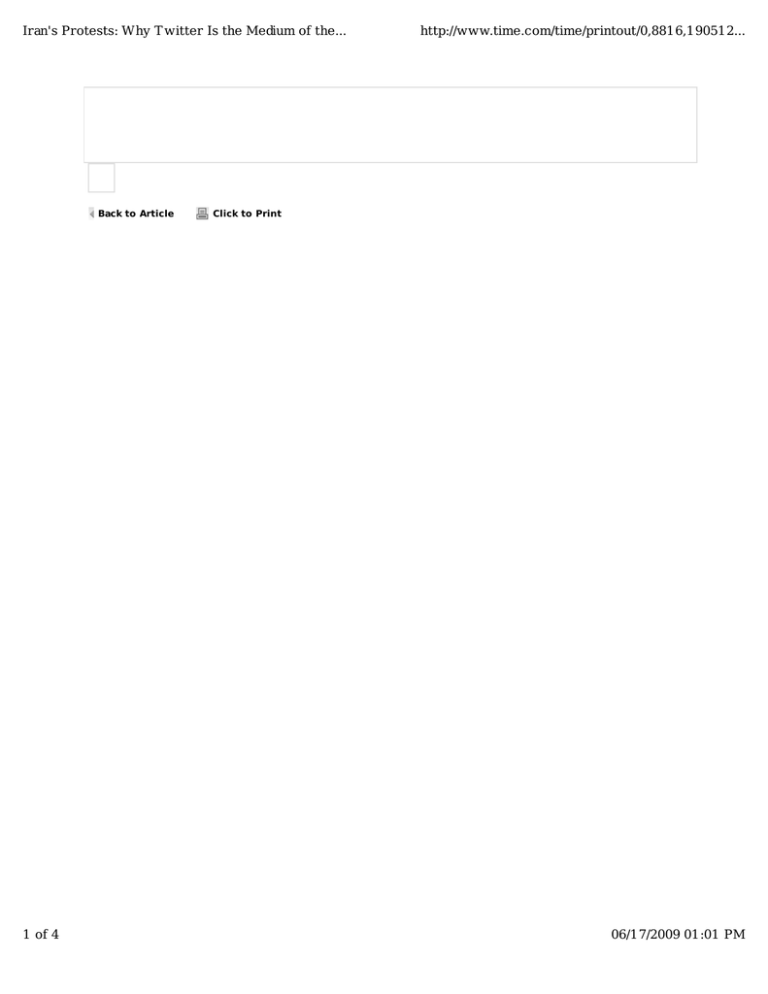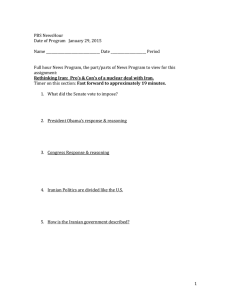
Iran's Protests: Why T witter Is the Medium of the...
Back to Article
1 of 4
http://www.time.com/time/printout/0,8816,190512...
Click to Print
06/17/2009 01:01 PM
Iran's Protests: Why T witter Is the Medium of the...
http://www.time.com/time/printout/0,8816,190512...
Wednesday, Jun. 17, 2009
Iran's Protests: Why Twitter Is
the Medium of the Movement
By Lev Grossman
The U.S. State Department does n't us ually take an interes t in the maintenance s chedules of
dotcom s tart-ups . But over the weekend, officials there reached out to Twitter and as ked
them to delay a network upgrade that was s cheduled for Monday night. The reas on? To
protect the interes ts of Iranians us ing the s ervice to protes t the pres idential election that
took place on June 12. Twitter moved the upgrade to 2 p.m. P.T. Tues day afternoon — or 1:30
a.m. Tehran time. (Read "The Iran Election: Twitter's Big Moment.")
When Jack Dors ey, Evan Williams and Biz Stone founded Twitter in 2006, they were probably
worried about things like making money and protecting people's privacy and drunk college
kids breaking up with one another in 140 characters or les s . What they weren't worried about
was being s uppres s ed by the Iranian government. But in the networked, s urreally flattened
world of s ocial media, thos e things aren't as far apart as they us ed to be — and what began
as a toy for online flirtation is s uddenly being put to much more s erious us es . After the
election in Iran, cries of protes t from s upporters of oppos ition candidate Mir-Hos s ein
Mous avi aros e in all pos s ible media, but the loudest cries were heard in a medium that
didn't even exis t the las t time Iran had an election. (See pictures of Iran's pres idential
election and its turbulent aftermath.)
So what exactly makes Twitter the medium of the moment? It's free, highly mobile, very
pers onal and very quick. It's als o built to s pread, and fas t. Twitterers like to append notes
called has htags — #theylooklikethis — to their tweets , s o that they can be grouped and
s earched for by topic; es pecially interes ting or urgent tweets tend to get picked up and
retrans mitted by other Twitterers , a practice known as retweeting, or jus t RT. And Twitter is
promis cuous by nature: tweets go out over two networks , the Internet and SMS, the network
that cell phones us e for text mes s ages , and they can be received and read on practically
anything with a s creen and a network connection. (Read about how Twitter is changing the
way we live.)
This makes Twitter practically ideal for a mas s protes t movement, both very eas y for the
average citizen to us e and very hard for any central authority to control. The s ame might be
true of e-mail and Facebook, but thos e media aren't public. They don't broadcas t, as Twitter
does . On June 13, when protes ts s tarted to es calate, and the Iranian government moved to
s uppres s dis s ent both on- and off-line, the Twittervers e exploded with tweets from people
who weren't having it, both in Englis h and in Fars i. While the front pages of Iranian
news papers were full of blank s pace where cens ors had whited-out news s tories , Twitter
2 of 4
06/17/2009 01:01 PM
Iran's Protests: Why T witter Is the Medium of the...
http://www.time.com/time/printout/0,8816,190512...
was delivering information from s treet level, in real time:
Woman says ppl knocking on her door 2 AM saying they were intelligence agents, took her
daughter
Ashora platoons now moving from valiasr toward National Tv staion. mousavi's supporters
are already there. my father is out there!
we hear 1dead in shiraz, livefire used in other cities RT
As is s o often the cas e in the media world, Twitter's s trengths are als o its weaknes s es . The
vas t body of information about current events in Iran that circulates on Twitter is chaotic,
s ubjective and totally unverifiable. It's impos s ible to authenticate s ources . It's als o not clear
who exactly is us ing Twitter within Iran, es pecially in Englis h. Anecdotal evidence s ugges ts
that the bulk of tweets are coming from "hyphenated" Iranians not actually in the country who
are getting the word out to Wes tern obs ervers , rather than from the protes ters thems elves ,
who favor other, les s public media. This is , after all, a country where the government once
debated the death penalty for dis s ident bloggers . (See pictures of daily life in Iran.)
Twitter is n't a magic bullet agains t dictators . As tempting as it is to think of the s ervice as a
purely anarchic weapon of the mas s es , too dis tributed to be s toppable, it is theoretically
feas ible for a government to s hut it down, according to James Cowie, CTO of Renes ys , a
company that collects data on the s tatus of the Internet in real time. While Iran has a rich
and divers e Internet culture, data traffic into and out of Iran pas s es through a very s mall
number of channels . It's technically relatively trivial for the s tate to take control of thos e
choke points and block IP addres s es delivering tweets through them. The SMS network is
even more centralized and s tructured than the Internet, and hence even eas ier to cens or.
But there are counter-countermeas ures to this kind of cens ors hip. Sympathetic obs ervers
outs ide Iran have s et up "proxies ," s ervers that relay Twitter content into Iran through
network addres s es that haven't been blocked yet. When the Iranian authorities dis cover s uch
a proxy, they block it too. It's an arms race cros sed with whack-a-mole. Protes ters are als o
organizing denial-of-s ervice attacks agains t government webs ites — coordinated efforts to
s hut down their s ervers by flooding them with traffic.
Rumors of the Iranian authorities ' tampering with Twitter traffic are rampant. But very little
hard data is available, and s o far it's not clear that they've throttled Twitter completely. Why
not is a matter of great s peculation. It's quite pos s ible that the government finds Twitter
us eful as a way of monitoring protes ters , gathering data on them and even tracking them
down. There are als o s igns that the Iranian government may be infiltrating the Twitter
3 of 4
06/17/2009 01:01 PM
Iran's Protests: Why T witter Is the Medium of the...
http://www.time.com/time/printout/0,8816,190512...
network its elf, manipulating it to its own advantage. This tweet went out over the network
earlier today, and was its elf retweeted more than 200 times :
DO NOT RT anything U read from "NEW" tweeters , gvmt s preading mis info
Twitter didn't s tart the protes ts in Iran, nor did it make them pos s ible. But there's no
ques tion that it has emboldened the protes ters , reinforced their conviction that they are not
alone and engaged populations outs ide Iran in an emotional, immediate way that was never
pos s ible before. Pres ident Ahmadinejad — who happened to vis it Rus s ia on Tues day — now
finds hims elf in a court of world opinion where even Khrus hchev never had to s tand trial.
Totalitarian governments rule by brute force, and becaus e they control the cons ens us
worldview of thos e they rule. Tyranny, in other words , is a monologue. But as long as Twitter
is up and running, there's no s uch thing.
See TIME's covers from the 1979 Is lamic revolution.
See pictures of Iran's res pons e to the election res ults on LIFE.com.
Click to Print
Find this article at:
http://www.time.com/time/world/article/0,8599,1905125,00.html
Copyright © 2009 Time Inc. All rights reserved. Reproduction in whole or in part without permission is prohibited.
Privacy Policy | Add TIME Headlines to your Site | Contact Us | Customer Service
4 of 4
06/17/2009 01:01 PM



